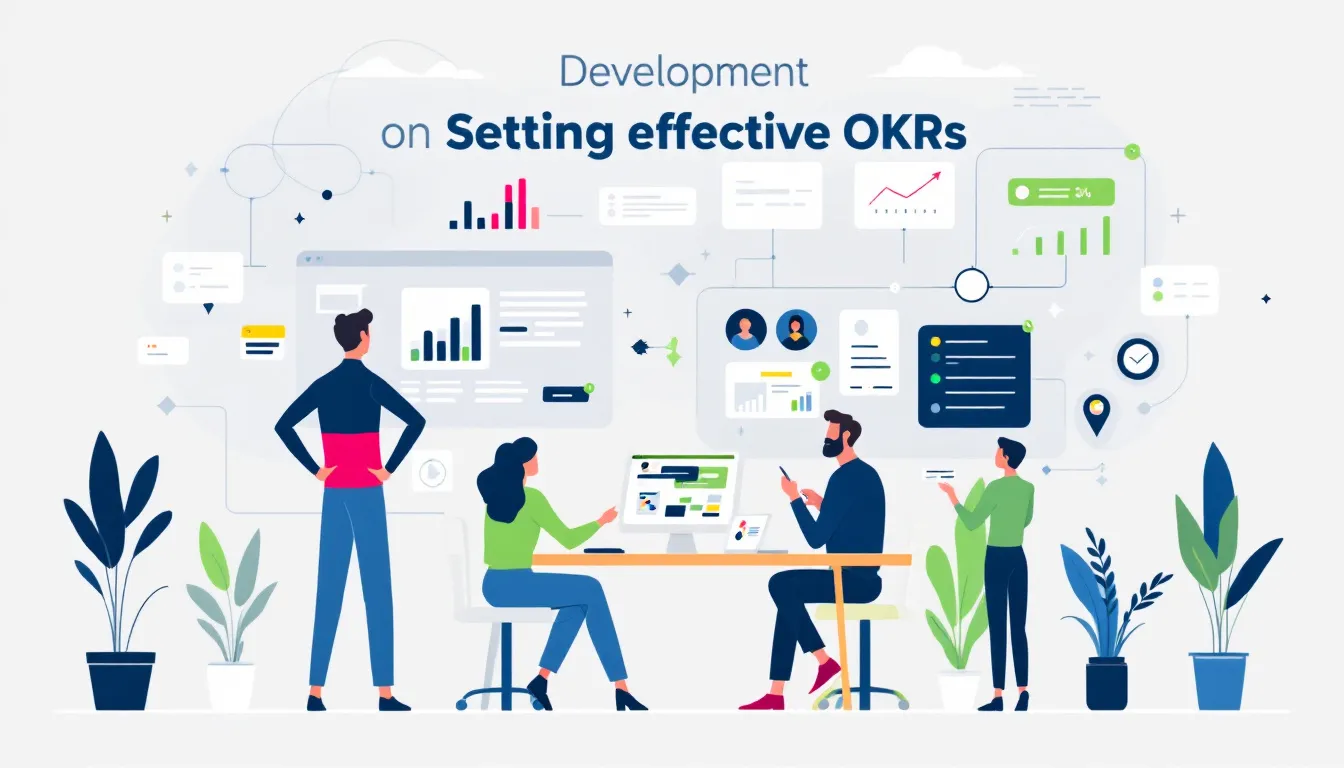Using OKRs to align software development goals ensures that your team’s efforts support business objectives. OKRs provide clear, measurable goals that drive focus and accountability. This article covers what OKRs are, how to use them in development teams, and best practices for success.
Understanding OKRs in Software Development
The concept of OKRs was introduced in the 1970s at Intel and has since become a cornerstone for goal-setting in tech companies. OKRs, or Objectives and Key Results, are designed to connect engineering efforts with business outcomes, ensuring that every team member is working towards the same strategic objectives and team okrs. OKRs provide a framework for aligning these goals effectively.
At the heart of OKRs are two components: objectives and key results. Objectives are concise, memorable, and motivational statements that define what you aim to achieve. Key results, on the other hand, are specific, measurable outcomes that track progress towards the objectives. This framework encourages clear goal-setting and frequent assessments, fostering a culture of accountability and continuous improvement within the development process.
Implementing OKRs in software development teams offers numerous benefits:
- They help achieve goal alignment across teams.
- They support broader organizational objectives.
- They complement performance KPIs, enhancing the overall tracking of progress towards development goals.
- They promote a collaborative approach.
- They empower development teams to take ownership of their goals and contribute meaningfully to the company’s success.
Differentiating OKRs from KPIs
While OKRs and KPIs might seem similar, they serve distinct purposes within an organization. OKRs are designed to guide improvement by establishing ambitious goals that drive change and growth. In contrast, KPIs monitor the consistency of performance against predefined metrics.
OKRs focus on defining desired outcomes and strategic objectives, aiming for transformative results rather than merely maintaining the status quo. Key performance indicators, on the other hand, measure ongoing performance and provide a benchmark for regular activities. By integrating both OKRs and KPIs, organizations can enhance the context and direction of performance measurement, ensuring that high-level goals align with daily operations.
Incorporating KPIs within the OKR framework enhances tracking and evaluating the success of OKRs, clarifying priorities and helping set measurable goals aligned with broader business objectives. Including KPIs in the OKR methodology enables teams to focus on ambitious goals and consistent performance, creating a balanced approach to achieving organizational objectives.
Setting Effective OKRs for Development Teams

Effective OKRs keep development teams focused and motivated. Key principles for effective OKRs include:
- Balancing high-level objectives with measurable quarterly goals to facilitate regular assessments of progress.
- Making objectives concise and inspiring to enhance team engagement and motivation.
- Ensuring that OKRs align with the organization’s vision to support overall business goals.
Key results should be limited to two to five measurable key results to maintain focus and clarity. Establishing a clear link between objectives and key results helps teams measure progress effectively. For example, an objective to improve code quality could be supported by a key result such as reducing the number of bugs or increasing unit test coverage.
Fostering a culture of continuous improvement and integrating automated test coverage frameworks can boost unit test coverage to increase unit test coverage as part of OKR strategies, meeting code quality objectives effectively. This approach not only enhances technical execution but also ensures that development teams are constantly striving to increase automated test coverage for excellence.
Involving team members in the OKR-setting process ensures commitment and ownership. Valuing team members’ input enhances their engagement and motivation to achieve set goals. This collaborative approach also helps in aligning OKRs with Agile practices, allowing for rapid adaptation and continuous alignment with the development cycle, fostering team involvement.
Best Practices for Implementing OKRs
Implementing OKRs effectively requires a structured and collaborative approach. An effective OKR framework includes:
- Encouraging team collaboration
- Iterative goal refinement
- Involving stakeholders in the creation of OKRs to foster alignment and commitment towards company objectives.
Team collaboration in setting OKRs enhances commitment to achieving code quality objectives. Fostering involvement and ownership among team members is critical when setting goals, improving engagement and ensuring that OKRs are relevant and achievable. This approach not only improves engagement but also ensures that OKRs are relevant and achievable.
Regular communication about OKRs and progress updates enhances transparency and alignment. OKRs should evolve through quarterly reviews to prevent stagnation and ensure ongoing relevance. Providing training and support helps employees grasp the OKR methodology and their specific roles within it.
Balancing the number of OKRs is also important, as having too many can reduce focus and hinder progress.
Examples of OKRs for Software Engineers
To illustrate how OKRs can be applied in a software development context, let’s look at some examples for software engineers. Engineering OKRs can improve the end user experience by targeting performance, accessibility, and usability improvements. For instance, an objective might aim for a specific percentage increase in system reliability or a reduction in page load times.
Key focus areas for the next quarter’s engineering OKRs could include scalability, tech debt reduction, and new feature rollouts. For example, launching a successful mobile application could be measured by achieving a specified number of daily active users within the quarter.
Engineering teams can also integrate OKRs into data security by setting specific measures for security improvements, vulnerability assessments, or compliance standards.
By focusing on the following areas, development teams can create effective engineering OKRs that drive meaningful improvements and align with broader business goals:
- Product
- Performance
- Quality
- Security
- User experience
Tracking Progress and Measuring Success

Tracking progress and measuring success are critical components of the OKR methodology. Regular reviews of objectives and key results are essential to maintaining their relevance and effectiveness in a fast-changing environment. Visual dashboards can significantly enhance the tracking of OKRs by providing real-time performance insights to monitor ongoing performance.
Using collaborative tools fosters transparency within teams about progress and areas needing improvement. Integrating feedback loops into the tracking process can improve team accountability and responsiveness. As teams strive to celebrate achievements related to key results, the collaborative process can help keep teams aligned and boost team morale and foster engagement.
Key practices include:
- Using collaborative tools to foster transparency about progress and areas needing improvement
- Integrating feedback loops into the tracking process to improve accountability and responsiveness
- Celebrating achievements related to key results to boost morale and engagement
Regular assessments enable teams to adapt strategies based on ongoing data. Combining OKRs with Agile fosters a culture focused on performance, where teams learn from both their achievements and setbacks. Regularly reviewing and updating code quality OKRs maintains visibility on technical debt and ensures continuous improvement.
Aligning OKRs with Agile Methodologies
Integrating OKRs into Agile methodologies can enhance process efficiency and alignment with company goals. Effective integration involves:
- Defining objectives that resonate with the company’s vision
- Mapping these objectives to Agile iterations
- Incorporating OKRs into sprints
- Regularly assessing progress to maintain continuous alignment with company goals.
Agile tools assist in tracking progress toward OKRs and making adjustments based on feedback from the scaled agile framework ceremonies. This approach supports continuous alignment by helping keep track of work and enabling swift modifications based on feedback or changes in priorities using agile methodology.
Engineering OKRs should focus on measurable outcomes that enhance process efficiency, sprint predictability, or deployment frequency. Aligning OKRs with Agile principles ensures development teams’ goals are consistently aligned with broader business objectives and strategic goals.
Enhancing Code Quality and Technical Execution
Effective engineering OKRs should target measurable improvements in code quality, deployment speed, and system reliability. For example, an objective to enhance code quality could include key results like ensuring all pull requests are reviewed by two developers.
Reducing technical debt can be quantified by tracking the decrease in the number of technical debt issues over a set period. Teams should create OKRs around code coverage to enhance reliability, depending on their stage and quality concerns.
Focusing on these areas boost developer productivity, enhances code quality, and aligns technical execution with broader business goals.
Aligning OKRs with Business Strategy
Aligning OKRs with a company’s vision and values supports overall strategic goals. Effective alignment links organizational vision to the objectives and key results set at both annual and quarterly intervals. This integration sets clear objectives resonating with broader organizational goals and overarching company goals.
A cascading approach to OKRs helps teams understand how their specific objectives contribute to the overall organizational goals. This approach promotes visibility of goals and improves accountability through regular updates and progress checks.
Regularly measuring key results allows for timely adjustments toward achieving objectives. Integrating OKRs with Agile practices enhances organizational focus by aligning strategic goals with iterative development, ensuring continuous alignment with business priorities.
Summary
In summary, using OKRs in software development can significantly enhance team alignment, goal clarity, and overall performance. By setting clear objectives and measurable key results, development teams can ensure that their efforts are aligned with broader business objectives and strategic goals.
Adopting OKRs fosters a culture of continuous improvement and accountability, driving meaningful business outcomes. By integrating OKRs with Agile methodologies, development teams can achieve greater flexibility and responsiveness, ensuring that their goals remain relevant and impactful. Embrace the power of OKRs to drive your software development efforts towards success.



